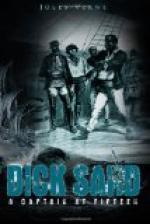This branch of the articulates counts six classes: insects, myriapodes, arachnides, crustaceans, cirrhopodes, and annelides.
Now, Cousin Benedict, scientifically speaking, would not know how to distinguish an earth-worm from a medicinal leech, a sand-fly from a glans-marinus, a common spider from a false scorpion, a shrimp from a frog, a gally-worm from a scolopendra.
But, then, what was Cousin Benedict? Simply an entomologist—nothing more.
To that, doubtless, it may be said that in its etymological acceptation, entomology is that part of the natural sciences which includes all the articulates. That is true, in a general way; but it is the custom to give this word a more restricted sense. It is then only applied, properly speaking, to the study of insects, that is to say: “All the articulate animals of which the body, composed of rings placed end to end, forms three distinct segments, and which possesses three pairs of legs, which have given them the name of hexapodes.”
Now, as Cousin Benedict had confined himself to the study of the articulates of this class, he was only an entomologist.
But, let us not be mistaken about it. In this class of the insects are counted not less than ten orders:
1. Orthopterans as grasshoppers, crickets, etc. 2. Neuropters as ant-eaters, dragon-flies or libellula. 3. Hymenopters as bees, wasps, ants. 4. Lepidopters as butterflies, etc. 5. Hemipters as cicada, plant-lice, fleas, etc. 6. Coleopters as cockchafers, fire-flies, etc. 7. Dipters as gnats, musquitoes, flies. 8. Rhipipters as stylops. 9. Parasites as acara, etc. 10. Thysanurans as lepidotus, flying-lice, etc.
Now, in certain of these orders, the coleopters, for example, there are recognized thirty thousand species, and sixty thousand in the dipters; so subjects for study are not wanting, and it will be conceded that there is sufficient in this class alone to occupy a man!
Thus, Cousin Benedict’s life was entirely and solely consecrated to entomology.
To this science he gave all his hours—all, without exception, even the hours of sleep, because he invariably dreamt “hexapodes.” That he carried pins stuck in his sleeves and in the collar of his coat, in the bottom of his hat, and in the facings of his vest, need not be mentioned.
When Cousin Benedict returned from some scientific promenade his precious head-covering in particular was no more than a box of natural history, being bristling inside and outside with pierced insects.
And now all will be told about this original when it is stated, that it was on account of his passion for entomology that he had accompanied Mr. and Mrs. Weldon to New Zealand. There his collection was enriched by some rare subjects, and it will be readily understood that he was in haste to return to classify them in the cases of his cabinet in San Francisco.




